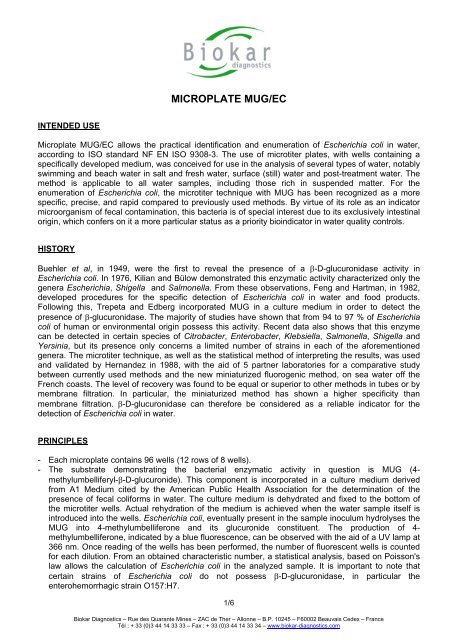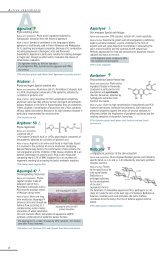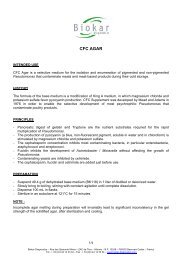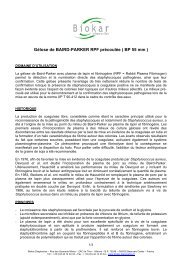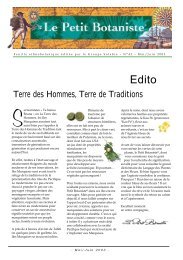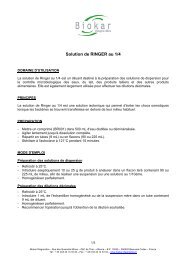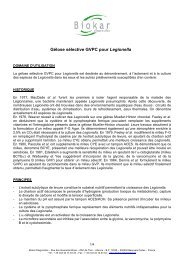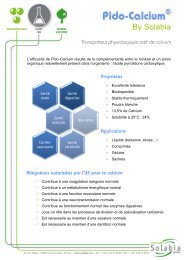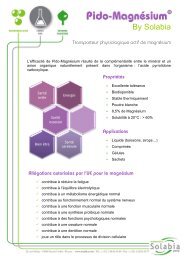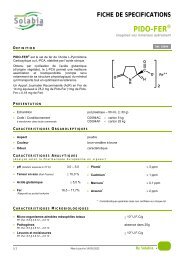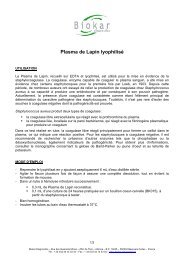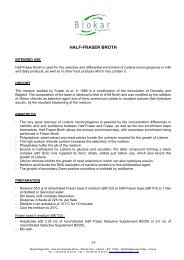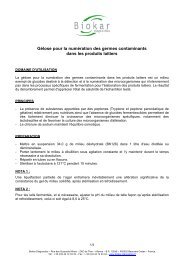MICROPLATE MUG/EC
MICROPLATE MUG/EC
MICROPLATE MUG/EC
You also want an ePaper? Increase the reach of your titles
YUMPU automatically turns print PDFs into web optimized ePapers that Google loves.
INTENDED USE<br />
<strong>MICROPLATE</strong> <strong>MUG</strong>/<strong>EC</strong><br />
Microplate <strong>MUG</strong>/<strong>EC</strong> allows the practical identification and enumeration of Escherichia coli in water,<br />
according to ISO standard NF EN ISO 9308-3. The use of microtiter plates, with wells containing a<br />
specifically developed medium, was conceived for use in the analysis of several types of water, notably<br />
swimming and beach water in salt and fresh water, surface (still) water and post-treatment water. The<br />
method is applicable to all water samples, including those rich in suspended matter. For the<br />
enumeration of Escherichia coli, the microtiter technique with <strong>MUG</strong> has been recognized as a more<br />
specific, precise, and rapid compared to previously used methods. By virtue of its role as an indicator<br />
microorganism of fecal contamination, this bacteria is of special interest due to its exclusively intestinal<br />
origin, which confers on it a more particular status as a priority bioindicator in water quality controls.<br />
HISTORY<br />
Buehler et al, in 1949, were the first to reveal the presence of a β-D-glucuronidase activity in<br />
Escherichia coli. In 1976, Kilian and Bülow demonstrated this enzymatic activity characterized only the<br />
genera Escherichia, Shigella and Salmonella. From these observations, Feng and Hartman, in 1982,<br />
developed procedures for the specific detection of Escherichia coli in water and food products.<br />
Following this, Trepeta and Edberg incorporated <strong>MUG</strong> in a culture medium in order to detect the<br />
presence of β-glucuronidase. The majority of studies have shown that from 94 to 97 % of Escherichia<br />
coli of human or environmental origin possess this activity. Recent data also shows that this enzyme<br />
can be detected in certain species of Citrobacter, Enterobacter, Klebsiella, Salmonella, Shigella and<br />
Yersinia, but its presence only concerns a limited number of strains in each of the aforementioned<br />
genera. The microtiter technique, as well as the statistical method of interpreting the results, was used<br />
and validated by Hernandez in 1988, with the aid of 5 partner laboratories for a comparative study<br />
between currently used methods and the new miniaturized fluorogenic method, on sea water off the<br />
French coasts. The level of recovery was found to be equal or superior to other methods in tubes or by<br />
membrane filtration. In particular, the miniaturized method has shown a higher specificity than<br />
membrane filtration. β-D-glucuronidase can therefore be considered as a reliable indicator for the<br />
detection of Escherichia coli in water.<br />
PRINCIPLES<br />
- Each microplate contains 96 wells (12 rows of 8 wells).<br />
- The substrate demonstrating the bacterial enzymatic activity in question is <strong>MUG</strong> (4methylumbelliferyl-β-D-glucuronide).<br />
This component is incorporated in a culture medium derived<br />
from A1 Medium cited by the American Public Health Association for the determination of the<br />
presence of fecal coliforms in water. The culture medium is dehydrated and fixed to the bottom of<br />
the microtiter wells. Actual rehydration of the medium is achieved when the water sample itself is<br />
introduced into the wells. Escherichia coli, eventually present in the sample inoculum hydrolyses the<br />
<strong>MUG</strong> into 4-methylumbelliferone and its glucuronide constituent. The production of 4methylumbelliferone,<br />
indicated by a blue fluorescence, can be observed with the aid of a UV lamp at<br />
366 nm. Once reading of the wells has been performed, the number of fluorescent wells is counted<br />
for each dilution. From an obtained characteristic number, a statistical analysis, based on Poisson's<br />
law allows the calculation of Escherichia coli in the analyzed sample. It is important to note that<br />
certain strains of Escherichia coli do not possess β-D-glucuronidase, in particular the<br />
enterohemorrhagic strain O157:H7.<br />
1/6<br />
Biokar Diagnostics – Rue des Quarante Mines – ZAC de Ther – Allonne – B.P. 10245 – F60002 Beauvais Cedex – France<br />
Tél : + 33 (0)3 44 14 33 33 – Fax : + 33 (0)3 44 14 33 34 – www.biokar-diagnostics.com
- The media composition, with its high level of peptone and salicin, allows excellent recuperation.<br />
- Triton X favors microorganism and fluorogen dispersion in the wells of the microtiter plate.<br />
- Incubation at 44°C was studied in order to inhibit the growth of the majority of contaminating<br />
microorganisms.<br />
INSTRUCTIONS FOR USE<br />
In order to proceed with the analysis of samples from chlorinated, brominated or ozonized waters, it is<br />
necessary to add, by sterile methods, excess sodium thiosulfate in the collecting container to neutralize<br />
the oxidents. In this way, total recuperation of the microorganisms to be detected can be obtained.<br />
PREPARATION AND DILUTIONS<br />
- Mix the sample well in order to obtain a homogeneous repartition of the microorganisms.<br />
- Proceed with an initial 1:2 dilution by transferring 18 mL of the sample in a tube containing 18 mL of<br />
diluent : reconstituted synthetic sea salt (without bromophenol blue) BR003, or ready-to-use<br />
Synthetic sea salt (with bromophenol blue indicator BM088).<br />
� For fresh water, bathing water and other surface water (salinity less than 30 g/Kg), use 18<br />
mL of the special microplate diluent (Synthetic Sea Salt - BR003 or BM088).<br />
� For sea water with a salinity greater than 30g/Kg (measured with the aid of a refractometer),<br />
use sterile distilled water (BM115) as a diluent.<br />
- Perform successive serial dilutions with the diluent BR003, BM088 or BM115. The number of<br />
dilutions to be inoculated is a function of the level of contamination in the tested sample.<br />
- The detection ranges for the number of microorganisms present in each sample category are listed<br />
in the following table:<br />
Sample type<br />
Bathing /<br />
swimming water<br />
Standing fresh<br />
water<br />
Effluent and post-<br />
treatment waters<br />
SAMPLE INOCULATION<br />
Number of<br />
dilutions<br />
2<br />
4<br />
6<br />
Number of wells per<br />
dilution<br />
64 wells at 1:2<br />
32 wells at 1:20<br />
24 wells at 1:2<br />
24 wells at 1:20<br />
24 wells at 1:200<br />
24 wells at 1:2000<br />
16 wells at 1:2<br />
up to<br />
16 wells at 1:200000<br />
2/6<br />
Detection range for microorganisms<br />
present (per 100 mL)<br />
1.5 x 10 1 to 3.5 x 10 4<br />
4.0 x 10 1 to 3.2 x 10 6<br />
6.0 x 10 1 to 6.7 x 10 8<br />
- Transfer the initial dilution into an appropriate sterile container.<br />
- By using a multi-channel pipette (8 sterile tips), inoculate 200 μL into each microtiter plate well.<br />
- In the same fashion, inoculate the subsequent dilutions (1:20, 1:200, 1:2000, etc.) by using a new<br />
recipient and new sterile pipette tips.<br />
- Well inoculation should be performed with care in order to avoid cross-contamination.<br />
- Cover each microtiter plate with a sterile adhesive cover furnished in the kit. This measure limits<br />
dehydration of the media in the wells and protects the plate from external contamination during the<br />
incubation period.<br />
Biokar Diagnostics – Rue des Quarante Mines – ZAC de Ther – Allonne – B.P. 10245 – F60002 Beauvais Cedex – France<br />
Tél : + 33 (0)3 44 14 33 33 – Fax : + 33 (0)3 44 14 33 34 – www.biokar-diagnostics.com
INCUBATION<br />
Incubate the microtiter plates at (44°C ± 0.5)°C for at least 36 hours, not exceeding a maximum of 72<br />
hours.<br />
READING<br />
The wells showing a blue fluorescence under 366 nm UV light are considered positive. Reading may<br />
be performed after the minimal period of incubation as the fluorescence does not diminish over time.<br />
The opaque microtiter plates (BT001) were developed for a visual reading and manual counting.<br />
RESULTS<br />
Determine the characteristic number from the number of positive wells for each of the chosen dilutions.<br />
In the event that more than 3 dilutions are inoculated, a characteristic number comprised of 3 numbers<br />
(if possible ending in 0) should be retained.<br />
MPN (Most Probable Number) and CONFIDENCE INTERVAL CALCULATION<br />
- The most probable number represents a statistical estimation of the concentration of<br />
microorganisms in a given sample. This estimation follows Poisson's Law. The upper and lower<br />
limits correspond to a 95% confidence level.<br />
- In the case of bathing water where 2 successive dilutions at 1:2 and 1:20 are inoculated into 64 and<br />
32 wells, respectively, the following example demonstrates the determination of the characteristic<br />
number, the MPN and its upper and lower limits.<br />
1 : 2 dilution : 25 positive wells out of 64<br />
1 : 20 dilution : 3 positive wells out of 32<br />
The characteristic number is 25/3<br />
In referring to the statistical table furnished in Annex 1, the example 25/3 indicates :<br />
MPN : 524 Escherichia coli / 100 mL<br />
Lower limit : 360 Escherichia coli / 100 mL<br />
Upper limit : 763 Escherichia coli / 100 mL<br />
For all other cases, refer to the annexes A and B of norm NF EN ISO 9308-3: March 1999. For still<br />
water and effluent testing, MPN tables are supplied upon demand.<br />
TYPICAL COMPOSITION<br />
<strong>MUG</strong>/<strong>EC</strong> medium<br />
Each microtiter plate well is filled with 100 μL of medium, of which the formula can be adjusted to<br />
obtain optimal performances :<br />
For 1 liter of medium :<br />
- Tryptone ........................................................................................40.0 g<br />
- Salicine ............................................................................................1.0 g<br />
- Triton X 100......................................................................................1.0 g<br />
- <strong>MUG</strong>.................................................................................................0.1 g<br />
pH : 6.9 ± 0.2.<br />
3/6<br />
Biokar Diagnostics – Rue des Quarante Mines – ZAC de Ther – Allonne – B.P. 10245 – F60002 Beauvais Cedex – France<br />
Tél : + 33 (0)3 44 14 33 33 – Fax : + 33 (0)3 44 14 33 34 – www.biokar-diagnostics.com
Synthetic Sea Salt<br />
The diluent is composed of synthetic sea salt, presented in dehydrated form without bromophenol blue,<br />
BR003, or as ready-to-use 18 mL tubes with bromophenol blue, BM088.<br />
The reconstitution of the dehydrated diluent is as follows :<br />
- Dissolve 22.5 g of synthetic sea salt in 1 liter of distilled or demineralized water.<br />
- Mix slowly until complete dissolution.<br />
- Distribute into 20 x 200 mm tubes; 9 mL or 18 mL per tube, according to the specific need.<br />
- Sterilize in an autoclave at 121°C for 15 minutes.<br />
NOTE :<br />
After preparation, the medium is clear and limpid. Occasionally after prolonged storage, a slight<br />
precipitate can be observed that has no incidence on the performance of the method.<br />
QUALITY CONTROL (following NF EN ISO 9308-3: March 1999, annex E) :<br />
- Background less than 25% of the positive threshold.<br />
- Fluorescence more than twice the positive threshold.<br />
- Fertility: 0.66 to 1.5 times the target value.<br />
STORAGE / SHELF LIFE<br />
Microtiter plates : 2-8°C.<br />
- The expiration date is indicated on the label.<br />
Synthetic sea salt (without bromophenol blue), dehydrated : 2-30°C.<br />
- The expiration date is indicated on the label.<br />
Synthetic sea salt (without bromophenol blue), reconstituted (benchmark value*) :<br />
- Medium in vials or in tubes : 6 months at 2-25°C.<br />
Diluent (Synthetic sea salt, with bromophenol blue), ready-to-use,<br />
Sterile distilled water, ready to use :<br />
- Store between 2-25°C, shielded from light.<br />
- The expiration dates are indicated on the labels.<br />
PRESENTATION Code<br />
Microplates, solid white<br />
- Kit containing 25 microtiter plates + BT00108<br />
25 sterile transparent adhesive covers<br />
Synthetic Sea Salt (without bromophenol blue), dehydrated :<br />
- 100 g bottle BR00308<br />
Synthetic Sea Salt (with 0.004 g/L bromophenol blue), ready-to-use :<br />
- 50 x 18 mL tubes BM08808<br />
Sterile distilled water, ready-to-use :<br />
- 50 x 18 mL tubes BM11508<br />
4/6<br />
Biokar Diagnostics – Rue des Quarante Mines – ZAC de Ther – Allonne – B.P. 10245 – F60002 Beauvais Cedex – France<br />
Tél : + 33 (0)3 44 14 33 33 – Fax : + 33 (0)3 44 14 33 34 – www.biokar-diagnostics.com
BIBLIOGRAPHY<br />
BUEHLER, H.J., KATZMAN, P.A., and DOISEY, E.A.. 1949. Bacterial glucuronidase. Federation Proceedings, 8 : 189.<br />
COCHRAN, W.G.. 1950. Estimation of bacterial densities by means of the "Most Probable Number". Biometrics, 6 : 105-116.<br />
de MAN, J.C.. 1975. The probability of most probable numbers. European Journal of Applied Microbiology, 1 : 76-78.<br />
KILIAN, M., and BÜLOW, P.. 1976. Rapid diagnosis of Enterobacteriaceae. I. Detection of bacterial glycosidases. Acta<br />
Pathologica et Microbiologica Scandinavica Section B, 84 : 245-251.<br />
FENG, P.C.S., and HARTMAN, P.A.. 1982. Fluorogenic assays for immediate confirmation of Escherichia coli. Applied<br />
Environmental Microbiology, 43 :1320-1329.<br />
HURLEY, M.A., and ROSCOE, M.E.. 1983. Automated statistical analysis of microbial enumeration by dilution series. Journal<br />
of Applied Bacteriology, 55 : 159-164.<br />
TREPETA, R.W., and EDBERG, S.C.. 1984. Methylumbelliferyl-β-D-glucuronide-based medium for rapid isolation and<br />
identification of Escherichia coli. Journal of Clinical Microbiology, 19 : 172-174.<br />
HERNANDEZ, J.F., GUIBERT, J.M., DELATTRE, J.M., OGER, C., CHARRIERE, C., HUGUES, B., SERCEAU, R., and<br />
SINEGRE, F.. 1991. Miniaturized fluorogenic assays for enumeration of E.coli and enterococci in marine water. Water Science<br />
and Technology, 24 : 137-141.<br />
NF EN ISO 9308-3 (T 90-433). Mars 1999. Qualité de l’eau. Recherche et dénombrement des Escherichia coli et des<br />
bactéries coliformes dans les eaux de surface et résiduaires. Partie 3 : Méthode miniaturisée (nombre le plus probable) pour<br />
ensemencement en milieu liquide.<br />
NF T 90-461. Juillet 2001, NF T 90-461/A1. Juin 2005 et NF T90-461/A2. Mai 2007. Qualité de l’eau. Microbiologie. Contrôle<br />
qualité des milieux de culture.<br />
5/6<br />
Biokar Diagnostics – Rue des Quarante Mines – ZAC de Ther – Allonne – B.P. 10245 – F60002 Beauvais Cedex – France<br />
Tél : + 33 (0)3 44 14 33 33 – Fax : + 33 (0)3 44 14 33 34 – www.biokar-diagnostics.com
SUPPORT PHOTO<br />
Reference : BT00108<br />
Intended use : Identification and enumeration of Escherichia coli in water, according to ISO standard<br />
NF EN ISO 9308-3.<br />
Escherichia coli in water<br />
Microplate <strong>MUG</strong>/<strong>EC</strong><br />
Ref. : BT00108<br />
Incubation : 36 hours / 44°C<br />
Characteristics : Wells demonstrating a blue fluorescence under UV light at 366nm are<br />
considered positive (presence of E. coli in the water sample).<br />
*Benchmark value refers to the expected shelf life when prepared under standard laboratory conditions following manufacturer’s instructions. It is provided as a<br />
guide only and no warranty, implied or otherwise is associated with this information<br />
The information provided on the package or instructions takes precedence over the formulations or instructions described in this document.<br />
The information and specifications contained in this technical data sheet date from 2009-02-16.<br />
They are susceptible to modification at any time, without warning.<br />
Code document : BT001/A/2006-01 : 6.<br />
6/6<br />
Biokar Diagnostics – Rue des Quarante Mines – ZAC de Ther – Allonne – B.P. 10245 – F60002 Beauvais Cedex – France<br />
Tél : + 33 (0)3 44 14 33 33 – Fax : + 33 (0)3 44 14 33 34 – www.biokar-diagnostics.com


